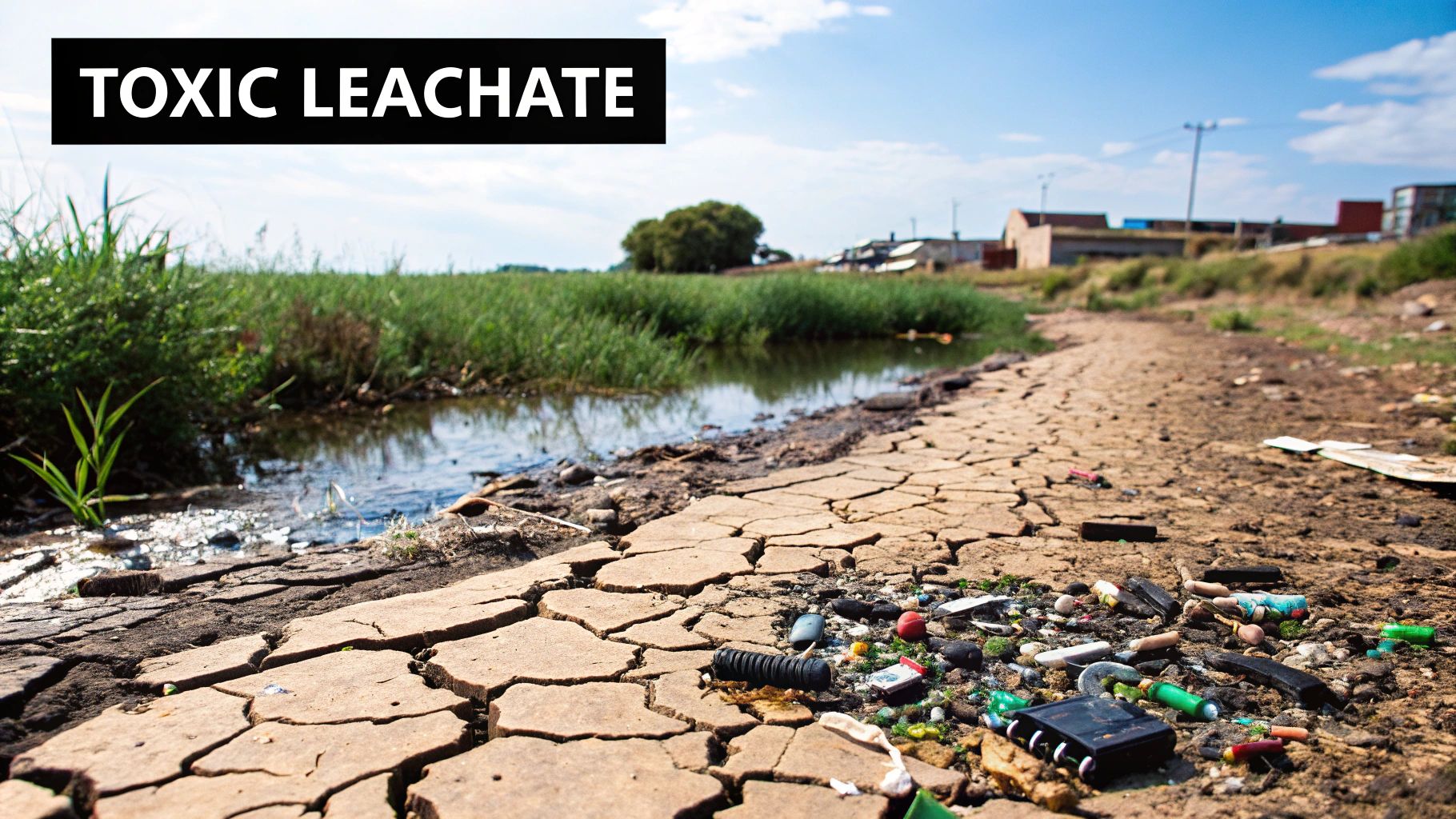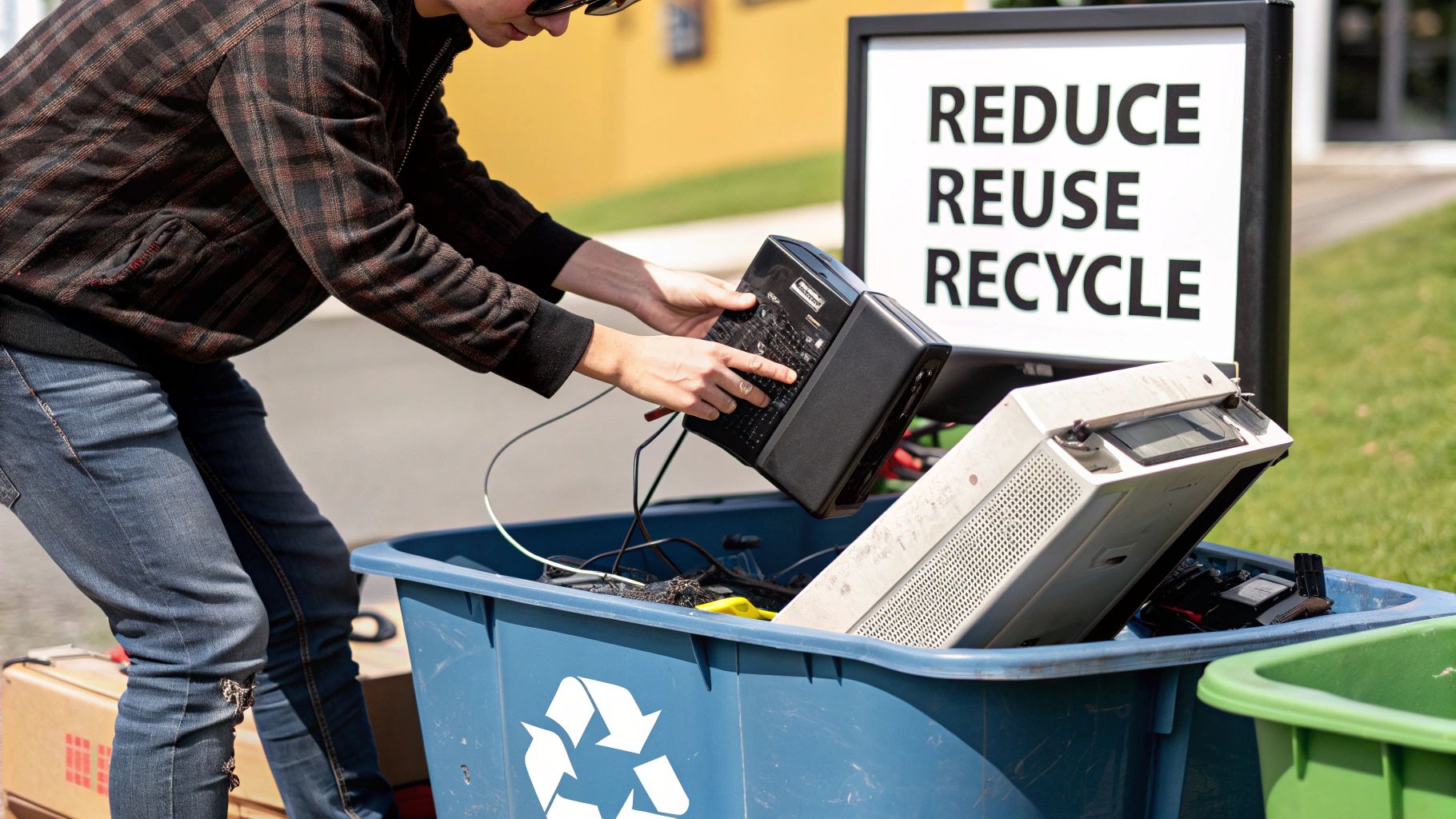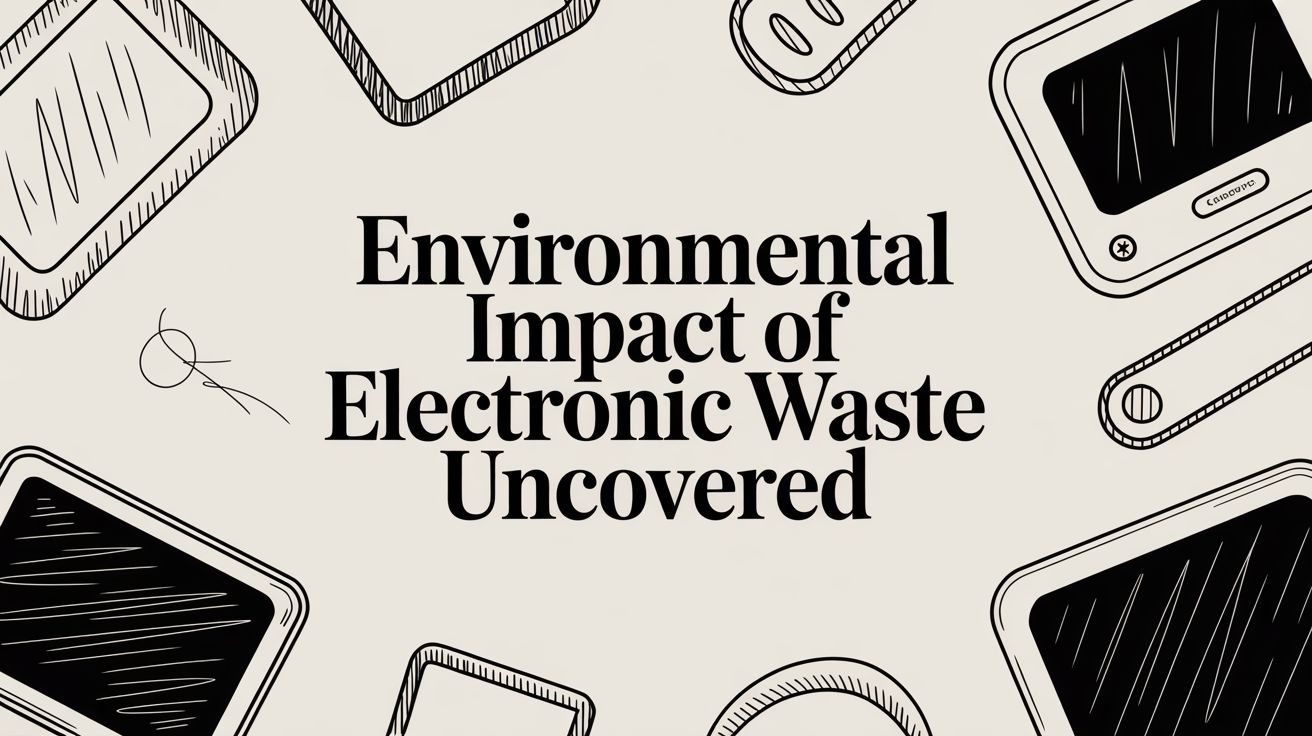The environmental impact of electronic waste is a crisis that's growing right under our noses, turning our planet into a dumping ground for a flood of discarded gadgets. These devices aren't just harmless junk; they're packed with toxic materials that cause long-term damage when they're not handled the right way.
The Growing Crisis of Digital Debris
Picture a river overflowing its banks. But instead of water, it’s filled with the smartphones, laptops, and appliances we toss out every day. That’s the reality of modern electronic waste, or e-waste. It covers everything from a pair of earbuds to massive data center servers that are unwanted, broken, or just old.
The sheer volume of this digital debris is hard to wrap your head around, and it's getting worse. In 2022 alone, the world generated an unbelievable 62 million metric tons of e-waste. That’s an 82% increase since 2010, and it's on track to jump another 33% by 2030—a pace that recycling just can't keep up with.
Why Is E-Waste Skyrocketing?
So, what’s fueling this explosion of old tech? For one, businesses are constantly faced with the challenge of managing outdated server hardware, which is a huge contributor. This endless cycle is really driven by a few key things:
- Rapid Innovation: New models with slightly better features pop up all the time, making perfectly good older devices feel obsolete.
- Shorter Product Lifespans: Let's be honest, many electronics aren't built to last. It’s often cheaper and easier to buy a new one than to get the old one fixed.
- Growing Consumption: Technology is part of everything we do now. The number of devices per person keeps climbing, which means more stuff eventually becomes waste.
This infographic gives you a sense of the massive scale of our "Digital Debris" problem, showing how our old gadgets are piling up.

The picture is clear: our buying habits are creating mountains of technological trash, turning what should be valuable resources into serious environmental hazards.
More Than Just Junk
Here's the tricky part about e-waste—it’s a paradox. On one hand, it's a treasure trove of valuable materials like gold, silver, and copper. On the other, it's a Pandora's box of hazardous substances.
When discarded improperly, devices release toxic materials like lead, mercury, and cadmium into the environment. This dual nature—valuable yet toxic—is what makes responsible management so critical.
To get a clearer picture, just think about what's inside the electronics you use every day.
Hazardous Materials Inside Your Electronics
This table breaks down common electronic devices to reveal the hazardous materials they contain and the direct environmental threats they pose when discarded improperly.
| Device Type | Common Hazardous Materials | Primary Environmental Threat |
|---|---|---|
| Smartphones & Tablets | Lead, Mercury, Arsenic, Cadmium | Contaminates soil and groundwater, bioaccumulates in wildlife. |
| Laptops & Computers | Lead (in CRT monitors), Mercury, Brominated Flame Retardants | Leaches into soil, pollutes air when burned, disrupts ecosystems. |
| Televisions (CRTs/LCDs) | Lead, Cadmium, Mercury, Beryllium | Heavy metal contamination of water sources and soil. |
| Servers & IT Equipment | Lead, Mercury, Hexavalent Chromium | Similar to computers but in higher concentrations, posing significant risk. |
| Batteries (all types) | Lithium, Cadmium, Lead, Mercury | Can leak and cause soil and water pollution, poses fire risks. |
Every device tossed into a landfill is another small toxic spill waiting to happen. Failing to deal with this crisis means we're not just wasting precious resources; we're actively poisoning our soil, water, and air for generations to come.
Understanding the real scope of this problem is the first step. For businesses and individuals ready to take action, professional services are the only way to go. You can learn more about certified e-waste recycling options that guarantee your old tech is disposed of safely and by the book.
How E-Waste Contaminates Our Soil and Water

When old electronics get tossed into a landfill, they don't just sit there quietly. They're more like toxic tea bags waiting for the next rain. As water filters through the dump, it soaks up a nasty brew of heavy metals and chemicals from the decaying gadgets, creating a poisonous liquid called leachate.
This toxic sludge is a cocktail of materials that were once safely sealed inside our devices. As it trickles down into the earth, it kicks off a chain reaction that contaminates the environment for decades to come. The real damage from e-waste begins long after we've thrown our old tech away.
From Gadget to Groundwater Poison
The contamination process is slow but incredibly destructive. Once leachate escapes the landfill or an unregulated dumpsite, it starts a journey that puts our most vital natural resources at risk.
First, it soaks into the surrounding soil. The ground acts like a sponge, absorbing toxins like lead from old monitors, mercury from flat-screen displays, and cadmium from rechargeable batteries. These elements don't break down—they just build up, turning fertile land toxic and barren.
This is a direct pipeline for toxins to enter our food chain. Plants and crops grown in this poisoned earth pull the heavy metals up through their roots, passing them on to animals and, eventually, to us.
A single old-school computer monitor can contain up to 8 pounds of lead. This is a powerful neurotoxin that can cause irreversible harm when it seeps into soil and groundwater.
This is a hidden danger that can turn productive farmland into a source of contamination, compromising the food safety of entire communities. The threat builds silently, making it hard to trace the consequences back to their electronic source.
Contaminating Our Most Precious Resource
As the leachate continues its journey downward, it eventually hits the groundwater. These underground aquifers supply drinking water for millions of people. Once they're contaminated, cleaning them up is incredibly difficult and expensive, if not impossible.
Think of an aquifer as a massive, natural underground reservoir. When chemicals like lead and mercury get in, they spread throughout the entire water system. This pollution can go unnoticed for years, silently poisoning the wells and taps that families and communities depend on.
This creates several severe risks:
- Unsafe Drinking Water: Even small amounts of heavy metal exposure can lead to serious health problems, from developmental issues in children to organ damage in adults.
- Ecological Damage: Contaminated groundwater eventually flows into rivers, lakes, and oceans, harming aquatic life and throwing entire ecosystems out of balance.
- Long-Term Scarcity: A polluted aquifer can become unusable for generations, creating severe water shortages in the affected areas.
The link between a discarded phone and a poisoned well is a sobering reminder that responsible electronics disposal isn't just an environmental issue—it's a public health crisis. The only way to stop these toxins is to prevent them from starting their destructive journey in the first place. For any organization looking to do its part, understanding professional e-waste disposal is the critical first step toward protecting our shared resources.
The Invisible Threat of Airborne E-Waste Toxins
While the damage e-waste does to soil and water happens largely out of sight, its impact on the air is a far more immediate and widespread problem. The environmental fallout from electronics isn't just a ground-level issue. When old gadgets are handled the wrong way, they release a plume of invisible toxins directly into the atmosphere we all share.
This airborne threat often comes from a dangerous, yet common, practice in informal recycling markets: open-air burning. To get at the tiny bits of valuable metals like copper locked away in wires and circuit boards, heaps of electronics are simply set on fire. It’s a crude but effective way to melt off plastic, but it comes at a devastating cost to air quality.
A Toxic Cocktail in the Air
Burning electronics is like setting off a chemical bomb in slow motion. The process unleashes a complex and hazardous mix of pollutants that can have serious consequences for both the environment and human health.
The smoke billowing from these fires is a dangerous cocktail, including:
- Dioxins and Furans: These are nasty compounds known as persistent organic pollutants (POPs). They are carcinogenic and can mess with hormones, leading to reproductive and developmental problems.
- Heavy Metals: Burning vaporizes heavy metals like lead, mercury, and cadmium, sending them straight into the air. Inhaling these can cause neurological damage and other severe health issues.
- Polycyclic Aromatic Hydrocarbons (PAHs): These form when organic materials don't burn completely and are linked to various forms of cancer.
Once these toxins are in the air, they don't just vanish. They get swept up into the global atmospheric cycle, capable of traveling thousands of miles from where they started.
Pollutants from a single e-waste burn pile in one corner of the world can be carried by wind currents across continents. Suddenly, it's contributing to air quality problems in communities that are nowhere near the original site.
This turns a local disposal problem into a global threat. It’s a powerful reminder of how interconnected our ecosystems really are, and how poor disposal practices in one place can create health risks for people everywhere.
Global Consequences of Local Actions
These airborne pollutants have effects that go far beyond just being inhaled. As the chemicals travel through the atmosphere, they can mix with water vapor and fall back to Earth as acid rain.
This acidified rain damages forests, changes the pH of lakes and rivers enough to harm aquatic life, and even corrodes buildings. It’s another way the toxic legacy of e-waste cycles right back into our soil and water systems.
On top of that, the respiratory illnesses linked to this kind of air pollution are a major public health crisis. Communities living near these informal processing sites, often in developing nations, suffer from much higher rates of asthma, bronchitis, and other lung conditions. It's a disproportionate impact that highlights the urgent need for safer, responsible solutions.
Preventing this airborne contamination starts with one simple rule: never let electronics end up in a burn pile. For businesses and organizations, professional electronics recycling is the only guaranteed way to ensure every single component is handled safely, keeping these dangerous toxins out of our air for good.
What E-Waste Exposure Does to Human Health
The environmental story of e-waste—polluted landscapes, tainted water—is only half the picture. The other, more devastating half is what it does to people. When toxic materials from our discarded gadgets seep into the environment, the abstract problem of e-waste becomes a very real, very personal public health crisis, hitting the world’s most vulnerable populations the hardest.
A huge portion of the world's e-waste gets shipped to developing nations. There, informal recycling economies spring up, offering a way for millions to make a living. But in these places, workers—often including children—dismantle complex electronics without any protective gear. They are breathing in and touching a poisonous cocktail of heavy metals and chemicals every single day.
The Devastating Effects of Direct Contact
Think about what it's like to handle a shattered circuit board with your bare hands or breathe in the acrid smoke from burning plastic casings all day. For countless people, this isn't a hypothetical; it's their reality. The health risks are enormous, with specific toxins causing specific, life-altering damage.
- Lead: Found in old CRT monitors and solder, lead is a potent neurotoxin. Exposure can cause irreversible neurological damage, developmental delays in children, and kidney failure.
- Mercury: Used in flat-screen displays and batteries, mercury viciously attacks the central nervous system. It's especially dangerous for pregnant women, as it can cause severe developmental disorders in their unborn children.
- Cadmium: A component in rechargeable batteries and semiconductors, cadmium is a known carcinogen linked directly to kidney damage and brittle bones.
- Brominated Flame Retardants (BFRs): These chemicals are added to plastic casings to prevent fires. Unfortunately, they also disrupt hormone functions and can lead to serious reproductive and thyroid problems.
These aren't just bullet points on a list; they represent shattered lives and communities trapped in a vicious cycle of poverty and illness, all fueled by the world's insatiable appetite for new tech.
A Disproportionate Burden on the Vulnerable
Children are uniquely susceptible to these poisons. Their developing bodies absorb pollutants far more easily than adults, and their small size means they get a more concentrated dose. Exposure during childhood can lead to lifelong cognitive impairments, stunted growth, and a much higher risk of chronic diseases down the road.
The World Health Organization has sounded the alarm time and again, identifying e-waste exposure as a major emerging health threat to children. It’s a crisis that steals their health and their future, often before they've even had a chance to grow up.
This imbalance creates a profound ethical problem. The very communities bearing the brunt of our electronic consumption are the ones with the fewest resources to handle the resulting health emergencies. It's a stark reminder that the true price of our gadgets isn't paid at the store—it's paid by vulnerable people thousands of miles away.
The Problem Is Only Getting Bigger
This health crisis is growing right alongside the mountain of discarded electronics. Between 2010 and 2022, the total amount of global e-waste nearly doubled, jumping from 34 billion to a staggering 62 billion kilograms. This explosion, driven by our high-consumption, short-lifespan device culture, is completely overwhelming our ability to recycle it all safely. Formal recycling rates are still struggling to even reach 25%.
While Europe generates the most e-waste per person, the consequences hit hardest in regions that are totally unequipped to handle the toxic flood. You can explore more about these global e-waste trends and their implications.
The link is crystal clear: more e-waste means more exposure, which leads to more illness and suffering. This makes responsible, certified e-waste management not just an environmental issue, but a fundamental matter of human rights and global health.
The Economic Drain of Discarded Resources
Beyond the environmental nightmare, electronic waste is a massive economic failure. When we toss out our old gadgets, we're not just getting rid of plastic and glass. We're throwing away a modern-day treasure chest filled with valuable, and increasingly scarce, resources.
This whole "take-make-dispose" model we've been running on is incredibly backward. We pour huge amounts of energy and money into mining materials and manufacturing complex devices, only to bury them in a landfill a few years later. It's a colossal drain on the global economy, squandering materials that could easily be recovered and put back to use.
An Urban Mine of Untapped Value
You should start thinking of our landfills and storage closets as "urban mines." The electronics piled up in there contain a wealth of materials that are far more concentrated than what you'd find in a traditional mine.
For instance, a single metric ton of circuit boards can hold 40 to 800 times more gold than a metric ton of ore pulled from the earth. That’s just the start.
These devices are also packed with other valuable elements:
- Silver and Platinum: Absolutely essential for conductivity in circuits and components.
- Copper: The backbone of all wiring and connectors.
- Rare Earth Elements: Critical for the magnets, screens, and batteries that make modern tech work.
When we don't recycle this stuff, we’re forced to rely on destructive and expensive mining operations to keep up with demand. This just causes more environmental damage and makes our supply chains vulnerable to global politics and sudden price spikes.
The economic fallout from e-waste is staggering. In 2022 alone, the net economic loss was estimated at a mind-boggling 37 billion USD. On top of that, hazardous substances from this waste are responsible for another 78 billion USD in external costs, mostly from damage to human health and the environment.
The worst part? We're barely recovering any of it. Right now, only 1% of the demand for rare earth elements is met by recycling e-waste. We're still mining the other 99%. You can discover more insights from the Global E-waste Monitor 2024 to see just how deep the problem goes.
The Circular Economy as a Financial Solution
The answer to this economic bleeding is the circular economy—a smarter model designed to eliminate waste and keep materials in play for as long as possible. Instead of a one-way ticket to the landfill, valuable resources are recovered, recycled, and fed right back into the manufacturing cycle.
This approach flips the script, turning e-waste from a costly problem into a valuable asset. It sparks new economic opportunities in collection, refurbishment, and recycling, all while cutting our dependence on new materials. For businesses, adopting a circular model through professional services like computer recycling isn't just about doing the right thing; it’s a sharp financial move.
By embracing a circular approach, we can finally turn the tide. We can conserve our natural resources, slash pollution, and build a more resilient and profitable economy for everyone.
Your Role in Building a Sustainable Future

It’s easy to feel overwhelmed by the sheer scale of the e-waste problem. But here’s the good news: every decision we make about our gadgets is a chance to push back. We can be part of a healthier, circular economy instead of the old "take-make-dispose" treadmill.
The most powerful tool we have is shifting our mindset. It all starts with a simple but game-changing hierarchy: Reduce, Reuse, and Recycle. By putting these principles into practice, you can directly cut down the amount of e-waste poisoning our environment.
Embrace the Reduce and Reuse Mindset
Honestly, the best way to fight e-waste is to not create it in the first place. This is about prioritizing longevity over the latest shiny upgrade. Before you click "buy now," just ask yourself: can my current device be fixed? Could a refurbished model do the job just as well?
When it is time for a replacement, think about the device’s entire life.
- Choose Durability: Go for products built to last, with a reputation for solid construction and long-term software updates.
- Prioritize Repairability: Give your business to brands that make repairs simple and affordable, with available parts and clear instructions.
- Extend the Lifespan: If your electronics still work, give them a second life by donating or selling them. It’s a win-win that keeps useful tech out of the scrap heap. It’s worth understanding the environmental impact when you sell your phone to see how big a difference this makes.
Think about this: if we all just held onto our smartphones for one extra year, we’d cut CO2 emissions by an amount equal to taking two million cars off the road.
This isn’t just about reducing waste. It’s also about conserving the massive amounts of energy and raw materials needed to build new electronics from scratch.
Recycle the Right Way with Certified Partners
When a device is truly at the end of the road, recycling isn't just a good idea—it's essential. But not all recycling is created equal. Tossing your old laptop in the nearest bin or giving it to some random collector can do more harm than good, leading to the exact environmental damage we're trying to avoid.
This is where a professional, certified recycler makes all the difference. Companies like Montclair Crew are set up to handle every last component according to the strictest environmental and security standards.
Working with a certified expert gives you three critical guarantees:
- Environmental Compliance: They have strict, documented procedures for managing hazardous materials like lead and mercury, making sure they never contaminate our soil, water, or air.
- Data Security: Certified data destruction isn't an afterthought; it's a core service. They ensure every bit of your personal or business data is permanently wiped clean, protecting you from identity theft and data breaches.
- Resource Recovery: They use advanced methods to reclaim valuable metals and materials, putting them back into the manufacturing stream to build new products. This is what a true circular economy looks like.
Taking that final step to dispose of electronics properly is where it all comes together. Our guide on how to dispose of old computers safely breaks down everything you need to know. Your choices really do matter, and by partnering with the right experts, you become a key part of the solution.
Got Questions About E-Waste? We've Got Answers.
Jumping into the world of electronic waste can feel a little overwhelming. What counts? What doesn't? Where does it all go? Getting a handle on the basics is the best way to start making responsible choices. Here are some clear answers to the questions we hear most often.
What Common Household Items Are Considered E-Waste?
It's a huge category, covering pretty much anything with a plug, cord, or battery. Most people think of phones and laptops, but it goes way beyond that.
We're talking about old TVs, printers, microwaves, coffee makers, and even your kid's electronic toys. Don't forget the accessories, either—chargers, cables, and remote controls all count. If it has electronic parts and you're done with it, it's e-waste, not regular trash.
Why Can’t I Just Throw My Old Phone in the Garbage?
This is probably the single worst thing you can do with old electronics. Your old phone is packed with toxic heavy metals like lead, mercury, and cadmium. When it gets dumped in a landfill, those poisons eventually seep into the soil and groundwater.
That contamination makes its way into drinking water and farmland, creating a serious threat to the ecosystem and our health. And if that trash gets incinerated? Those toxins become airborne pollutants. Proper recycling is the only way to contain these hazards and pull out valuable materials like gold and copper for reuse, cutting down the massive environmental impact of electronic waste.
Think about it: a single smartphone holds dozens of different elements. Many are toxic if they escape. Recycling not only stops the poison from spreading but also recovers precious resources that we'd otherwise have to mine all over again.
How Do I Find a Responsible E-Waste Recycler?
Finding a certified, trustworthy recycler is key. You don't want your old equipment ending up on a barge to a developing country. A good place to start is your local city or county government's website; they often have lists of designated drop-off points or special collection events.
For businesses that need absolute certainty on security and environmental standards, look for recyclers holding certifications like e-Stewards or R2 (Responsible Recycling). These aren't just fancy badges; they're a guarantee that the recycler meets the highest ethical and environmental protocols. This is where a professional service that lives and breathes e-waste can offer true peace of mind.
Is My Personal Data Safe When I Recycle Electronics?
That's a great question, and the answer is: it depends on who you work with. Just hitting "delete" on your files does absolutely nothing to permanently erase them. Your personal info is still on there, just waiting for someone to recover it.
Any reputable e-waste recycler must offer certified data destruction as a standard part of their service. This isn't optional. It means using specialized software to wipe drives clean or physically shredding them into tiny pieces before anything gets dismantled. Always ask a potential recycler to walk you through their specific data destruction process—your privacy is just as important as protecting the environment.
Ready to handle your company's IT assets the right way? Montclair Crew provides certified electronics recycling and secure data destruction for businesses all over Metro Atlanta. We take the complexity out of protecting your data and the planet. Visit us online to schedule your pickup today.
